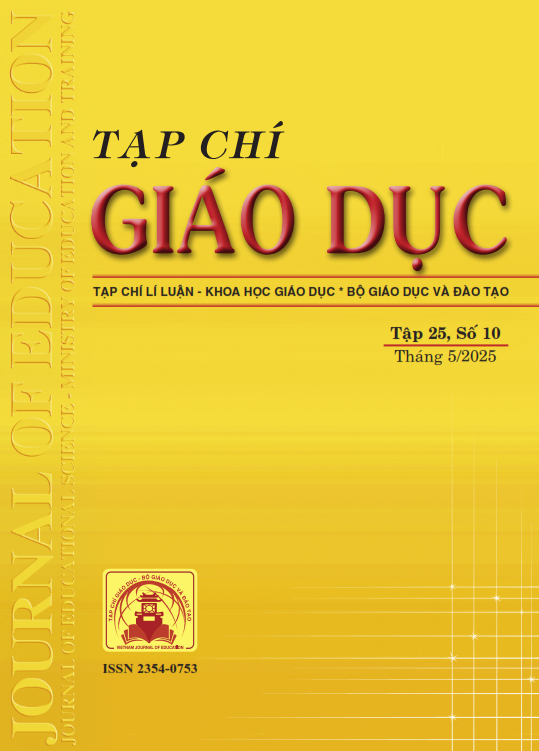Sử dụng chiến lược Giàn giáo trong dạy học nội dung Hình học ở lớp 10
Tóm tắt
“Scaffolding” is a teaching strategy that provides individual support, based on the learner’s zone of proximal development. The general philosophy when using the Scaffolding strategy in teaching is that each individual has varied understanding, is provided with necessary support; is created conditions to overcome difficulties, discover, master and develop their own knowledge. The study clarifies the concept and characteristics of the Scaffolding strategy, proposes a process for using the Scaffolding strategy in teaching Geometry content in grade 10, then illustrates this process through teaching the Cosine theorem. The objective of the study is to clarify the effectiveness of this teaching strategy in helping students access knowledge effectively, thereby developing thinking and mathematical problem-solving skills, creating motivation, confidence, and interest in learning, ultimately improving their academic performance and the effectiveness of teaching Mathematics in high school.
Tài liệu tham khảo
Anghileri, J. (2006). Scaffolding practices that enhance mathematics learning. Journal of Mathematics Teacher Education, 9(01), 33-52. https://doi.org/10.1007/s10857-006-9005-9
Bean, T. W., & Stevens, L. P. (2002). Scaffolding reflection for preservice and inservice teachers. Reflective Practice, 3(2), 205-218.
Bộ GD-ĐT (2018). Chương trình giáo dục phổ thông môn Toán (ban hành kèm theo Thông tư số 32/2018/TT-BGDĐT ngày 26/12/2018 của Bộ trưởng Bộ GD-ĐT). Chang, K., Chen, I., & Sung, Y. (2002). The effect of concept mapping to enhance text comprehension and summarization. The Journal of Experimental Education, 71(1), 5-23.
Dennen, V. P. (2004). Cognitive Apprenticeship in Educational Practice: Research on Scaffolding, Modeling, Mentoring, and Coaching as Instructional Strategies. In D. H. Jonassen (Ed.), Handbook of Research on Educational Communications and Technology (2nd ed., pp. 813-828). Mahwah, NJ: Lawrence Erlbaum Associates.
Gibbons, P. (2015). Scaffolding language, scaffolding learning (2nd edition). Heinemann.
Hammond, J. (2001). Scaffolding: teaching and learning in language and literacy education. Rozelle PETA.
Hartman, H. (2002). Scaffolding & Cooperative Learning. Human Learning and Instruction (pp. 23-69). New York: City College of City University of New York.
Holton, D. & Clark, D. (2006). Scaffolding and metacognition. International Journal of Mathematical Education in Science and Technology, 37, 127-143.
Ihechukwu, N. B. (2020). Impact of instructional scaffolding approach on secondary school students achievement in mathematics. Malikussaleh Journal of Mathematics Learning (MJML), 3(2), 46. https://doi.org/10.29103/ mjml.v3i2.3168
Kong, J. E., & Orosco, M. J. (2015). Word-Problem-Solving Strategy for Minority Students at Risk for Math Difficulties. Learning Disability Quarterly, 39(3), 171-181. https://doi.org/10.1177/0731948715607347
Lu, X. (2022). The application of scaffolding in junior school teaching. Highlights in Business, Economics and Management, 4, 342-349. https://doi.org/10.54097/hbem.v4i.3523
Lương Quốc Thái, Trần Trung Ninh (2022). Vận dụng lí thuyết giàn giáo của Vygotsky vào dạy học chủ đề môn Hóa học nhằm phát triển năng lực tự học cho học sinh. Tạp chí Khoa học, Trường Đại học Hải Phòng, 53, 117-125.
Oers, B. V. (2020). Scaffolding in mathematics education. In Lerman Encyclopedia of Mathematics Education, 759-762. https://doi.org/10.1007/978-3-030-15789-0_136
Pol, J. V. D., & Volman, M., & Beishuizen, J. (2010). Scaffolding in teacher - student interaction: A decade of research. Educational Psychology Review, 22(3), 271-296.
Puntambekar, S., & Hubscher, R. (2005). Tools for scaffolding students in a complex learning environment: What have we gained and what have we missed? Educational Psychologist, 40(01), 1-12.
Phí Thị Thùy Vân (2013). Xây dựng các “giàn giáo dạy học” giúp học sinh giỏi trung học cơ sở kiến tạo tri thức hình học. Tạp chí Khoa học, Trường Đại học Sư phạm Hà Nội, 58, 217-223.
Rittle-Johnson, B., & Koedinger, K. R. (2005). Designing Knowledge Scaffolds to Support Mathematical Problem Solving. Cognition and Instruction, 23(3), 313-349. https://doi.org/10.1207/s1532690xci2303_1
Siemon, D., & Virgona, J. (2003). Identifying and describing teachers’ scaffolding practices in mathematics. In Educational research: Risks and dilemmas: Proceedings of the New Zealand/Australian Association of Research in Education conference.
Stone, C. A. (1998). Should we salvage the scaffolding metaphor? Journal of Learning Disabilities, 31(4), 409-413.
Wei, P., & Cui, Y. (2024). Application of Scaffolding Teaching Method in the Course of Introduction to the English-speaking Countries. Journal of Educational Research and Policies, 6(11), 59-62. https://doi.org/10.53469/ jerp.2024.06(11).13
Williams, L. (2008). Tiering and scaffolding: Two strategies for providing access to important mathematics. Teaching Children Mathematics, 14(6), 324-330.
Wood, D., Bruner, J. S., & Ross, G. (1976). The role of tutoring in problem solving. Journal of Child Psychology and Psychiatry, 17(2), 89-100.
Tải xuống
Đã Xuất bản
Cách trích dẫn
Số
Chuyên mục
Giấy phép

Tác phẩm này được cấp phép theo Ghi nhận tác giả của Creative Commons Giấy phép quốc tế 4.0 .












